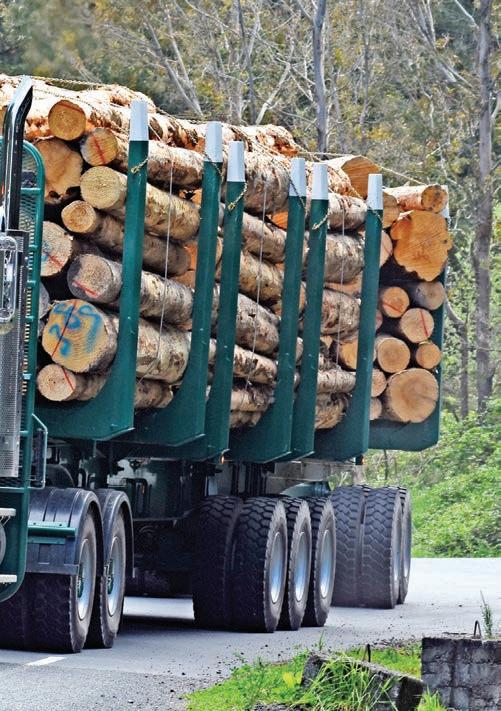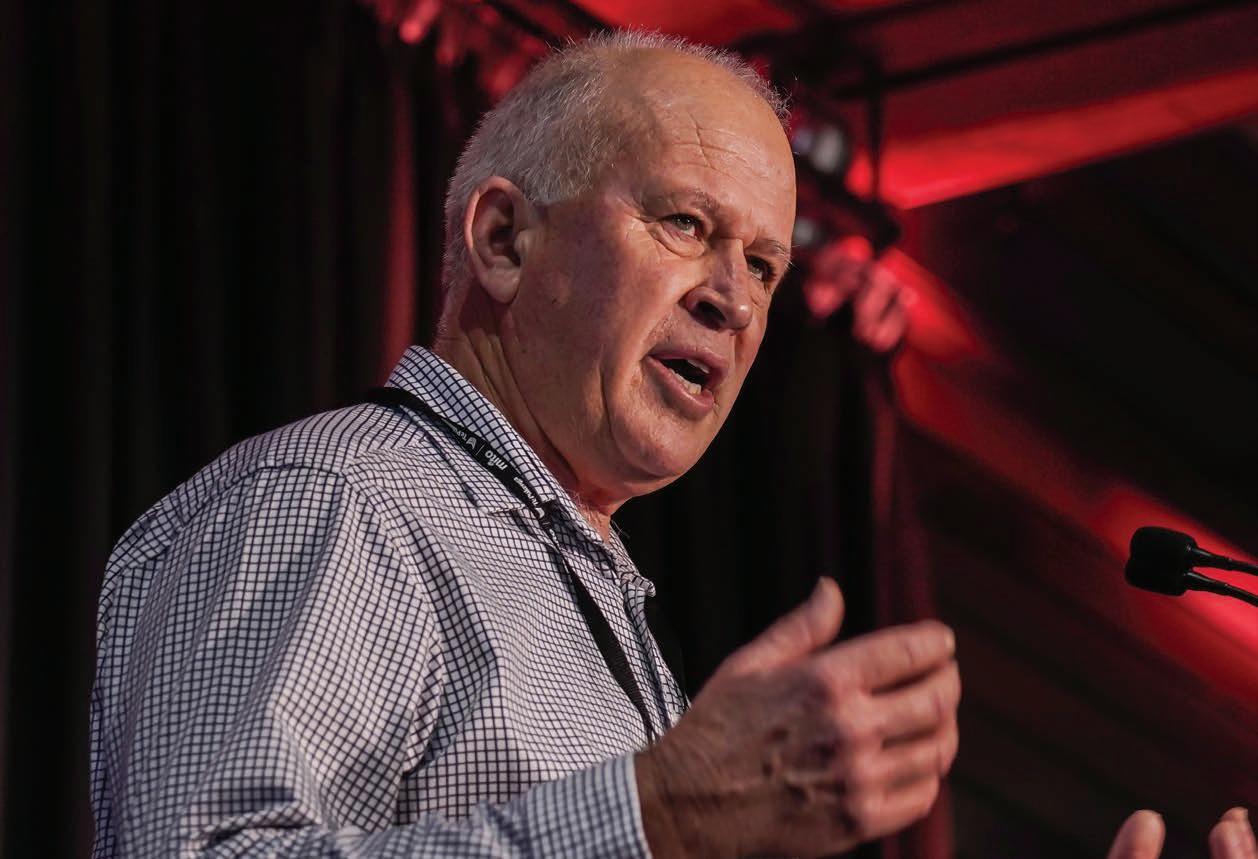
6 minute read
Transporting New Zealand
the road. Having Jake coach me through was a must.
The climb into the C509 cab isn’t too difficult for a high, bonneted truck. It’s three steps, two on the diesel tank and another just below the door. Once in the cab it’s a comfortable feel with the ISRI seat. The cab layout is what you would expect for an off-highway truck - more practical than flashy and giving you that classic Kenworth feel.
Moving off from low gear the weight is immediately felt, and the truck gives a little lurch as it gets all 15 axles moving. Once up into 1st low it’s one full gear change to second low and then the splits begin.
Pulling out of `The Web’ is a wide 90-degree bend and then a short straight run to another 90-degree left from a Stop sign. At both turns it seems like the third trailer is never going to come around the corner. But it does in good time and it’s quickly apparent to me how well these trailers track.
Stephen told me on my first day that you are never going to win any races in this truck, so patience is key. It’s a lot of gear changes just to get up to 30km/h and you need to remember what gear you are in at all times.
Luckily, I had Jake alongside to essentially tell me what gears to be in and when, otherwise I would never have been able to do this.
As we head through the tunnel that takes the forest road under the public highway there is a dip down and then a gradual climb out to a sweeping left-hand bend. It’s about careful road positioning, precise gear selection and the right amount of speed.
Under Jake’s instructions we clear the tunnel and carry on. On my short drive I must have changed more gears than in three truck tests combined!
With the next part of the route including undulating climbs and descents it is very important to be in the right gear at the right time and to use the engine brake at all times on the downhill. The service brake is very rarely used, and the trailer brake is dabbed once near the bottom of a hill that has a slight bend at the bottom.
I have to admit not every gear change was perfect and I did make some noise. I had to adjust the way I am used to driving the 18-speed as I usually keep it in gear when doing the splits. But Jake and Stephen take it out of gear, a way of reducing load on the drivetrain.
Doing this put me off a bit but Jake helped me through it. With the treble weighing more than 200t in total it’s all about being as gentle as you can with the drivetrain. You can’t be crashing and banging it or loading it up because it just won’t last.
I think the previous C509 is a testament to how well-suited the truck is to this work. Jake and Stephen covered 300,000km in four years with very little issues.
Once my drive is complete, I hand the truck back to Jake and the weight comes off my shoulders. It’s fair to say I was coming down from an adrenaline high and the experience was everything I hoped it would be.
I’d like to thank everyone involved in making this test happen. Firstly, Tony for giving me permission to drive, to Jake for making everything seem to easy and Stephen for letting me ride along for a few days.
I loved seeing a totally professional operation at work and sharing these special roads with some of the best drivers in the country. It’s like a family out there in the off-highway world with the bush radio offering feedback about what’s happening ahead as everyone looks out for each other.
And there is also plenty of humour thrown around too. There is nothing worse than going to work and not having a laugh. T&D
Kenworth C509 6x4 Day Cab
Engine: Cummins X15 six-cylinder in-line, Euro 5 Capacity: 15.0 litres Maximum Power: 431kW (578hp) at 1800rpm Maximum Torque: 2508Nm (1850 lb-ft) at 1200rpm Fuel capacity: Diesel 2 x 420 litres, AdBlue 170 litres Transmission: Eaton Fuller RTLO20918B 18-speed manual
Ratios:
1st – 14.40 2nd – 12.29 3rd – 8.51 4th – 7.26 5th – 6.05 6th – 5.16 7th – 4.38 8th – 3.74 9th – 3.20 10th – 2.73 11th – 1.00
12th – 2.28
13th – 1.62 14th – 1.38 15th – 1.17 16th – 1.00 17th – 0.86 18th – 0.73 Reverse – 14.4:1 Final Drive ratio: 5.56:1 Front axle: Meritor FL941LA rated at 9.1t Rear axles: SISU FR2P-32 (with diff locks to both drive axles
Brakes: Front Meritor 16.5 x 6 LA (Q+) drums; Rear SISU S-cam tandem drums
Auxiliary brakes: Cummins Engine Brake Front suspension: Kenworth Slipper Spring, Rear suspension: Kenworth KW6-60A 25.0t six rod suspension. GVM: 32,200kg GCM: 220,000kg
Ia Ara Aotearoa Transporting New Zealand Chairman Warwick Wilshier delivers his address to members at the Road Ahead Conference.

One voice must remain the aim for industry advocacy
by Nick Leggett Chief Executive Ia Ara Aotearoa Transporting New Zealand
THE ROAD AHEAD CONFERENCE HELD
at the end of September was not only the first conference for our members since 2019 but also marked the one-year anniversary of the merger of RTANZ into the Road Transport Forum to form Ia Ara Aotearoa Transporting New Zealand.
Unfortunately, National Road Carriers and the NZ Trucking Association (OCANZ) decided that the desire to form one management structure to advocate on behalf of the industry was not for them and went in their own direction. Despite this there has been considerable progress in the past year to rationalise and make better use of our resources and provide better advocacy and support for our members.
The old truism, the whole being greater than the sum of its parts has certainly proved to be the case at Transporting New Zealand. As Chairman Warwick Wilshier told delegates at the Conference, “change is not yet over for the road transport industry. The ultimate aim is for us to have one strong and powerful organisation.”
This may seem to some as if we are flogging a dead horse but ever since the Road Transport Forum was formed this has been the goal and if you look at the sectors around the country that are best represented, they are represented by one organisation speaking with the unified voice of the entire industry behind it.
One of the initiatives we have introduced to our advocacy over the last couple of years has been a greater reliance on industry data to make our case. Some of this has come by way of the surveys that many transport businesses have contributed to, and I want to thank everyone who has done that. I understand that these things can take time to fill out but the insights they give us and the information they provide is invaluable in the work we do with ministers and government officials.
A lot of people think government relations (lobbying, as it is so often termed) is easy. Well, I have been doing it for a long time and, believe me, it is not. To provide government with a convincing case to support your cause you need to deliver very credible evidence. Anecdotal stories and unsubstantiated claims just do not cut it.
In this context I was very disappointed to see recent media stories of a transport industry shortfall of as many as 9,000 drivers and warnings of dire consequences unless the Government massively increases immigration to let more drivers come in.
Not only was the 9,000-driver figure not backed up by evidence but the demand for the Government to let more drivers in only prompted Michael Wood, who is conveniently Minister for Transport, Immigration and Workplace Relations, to give our industry a big flick over wages and working conditions.
Now, we know that wages and working conditions have massively improved in our industry over recent years but when you back a minister into a corner like that then they will bite back and as his comments were also reported publicly, this does










